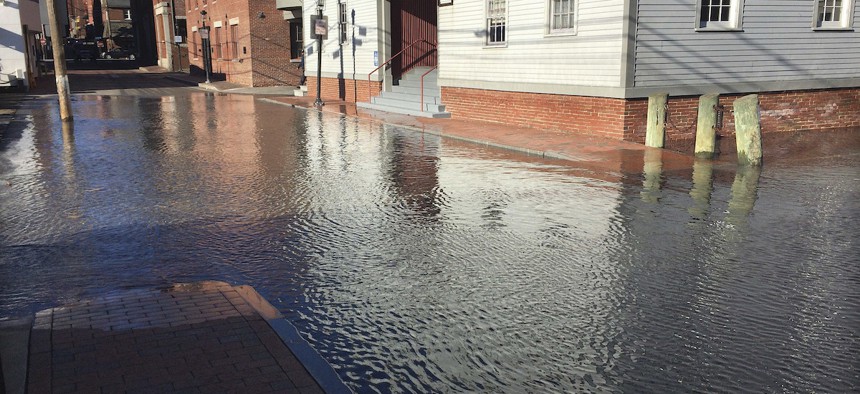States Take the Reins in Resilience Planning

High tide floods a street Friday, Nov. 18, 2016, in Portland, Maine Associated Press
Governors say states are taking steps to assure their long-term resiliency in the face of worsening climate change—and in the absence of sweeping federal action.
In the absence of strong federal actions to address climate change, states are beginning to implement their own measures to ensure long-term resiliency, governors said Sunday at the National Governors Association winter meeting in Washington, D.C.
“Everyone says, ‘It can’t happen here,’ until it does happen here. And it can happen in any one of our states,” Janet Mills, the governor of Maine, said during a panel discussion on state-level resilience planning. “I think we all sat back for years and said, ‘If something happens, FEMA will help us out.’ We need to start this at home.”
Maine has seen firsthand evidence of climate change, including extensive flooding and the looming loss of what Mills called “working waterfront.” To prepare for future events, Mills said, the state has undertaken a host of “decisive actions” aimed at mitigation, including the implementation of an electric vehicle rebate program, a goal to achieve statewide carbon neutrality by 2045. The state has also launched a “100,000 heat pump initiative” designed to help residents ease their dependence on fossil fuels.
“Maine is the most fossil-fuel dependent state when it comes to heating sources,” she said.
The initiative, signed into law last summer, aims to install 100,000 high-efficiency heat pumps in the state by 2025. The ductless pumps work by extracting heat from outside air and directing it indoors. The state provides rebates for residents to purchase qualifying pumps for their homes, which can help reduce energy costs. The Maine governor’s mansion is outfitted with 22 of the pumps, which Mills said were installed by her predecessor, Republican Gov. Paul LePage.
“So it really is a bipartisan effort,” said Mills, a Democrat.
Resiliency planning can extend beyond green infrastructure to include cybersecurity, North Dakota Gov. Doug Burgum told the panel.
“We’re on the front lines of a new battle relative to resiliency in our infrastructure, and that’s that...every day, every state, many of our communities are under attack, not from hackers that are sitting in the basement in their pajamas but by foreign national efforts to break into the key assets we have,” he said. “There are risks and hidden threats that go way beyond the important things we work on every day, like flood protection.”
Cybersecurity is particularly important in North Dakota, Burgum said, due to its placement on two national power grids and the Dakota Access Pipeline. Last year, the state became the first in the nation to implement a centralized cybersecurity strategy across all state agencies, a move supported by the legislature.
North Dakota defends against more than 5 million cyber attacks each month, said Burgum, a Republican.
“I’m confident there isn't any state in the country that’s spending too much on cybersecurity,” he said.
In California, where residents have experienced three consecutive record-breaking fire seasons, Democratic Gov. Gavin Newsom worked to highlight business and community partnerships and established a website to help connect affected residents to resources.
There are opportunities for innovation in disaster recovery and long-term planning, Newsom said, but taking advantage of them requires bipartisanship and acceptance of the reality of climate change.
“If any of you are still confused by science or still don’t believe in climate change, come to California. Mother Nature has joined the conversation,” he said. “I just hope we can move past this dialectic back-and-forth, and folks can start to wake up to this reality in a more meaningful and systemic way.”
Kate Elizabeth Queram is a Staff Correspondent for Route Fifty and is based in Washington, D.C.
NEXT STORY: Containing the Coronavirus





